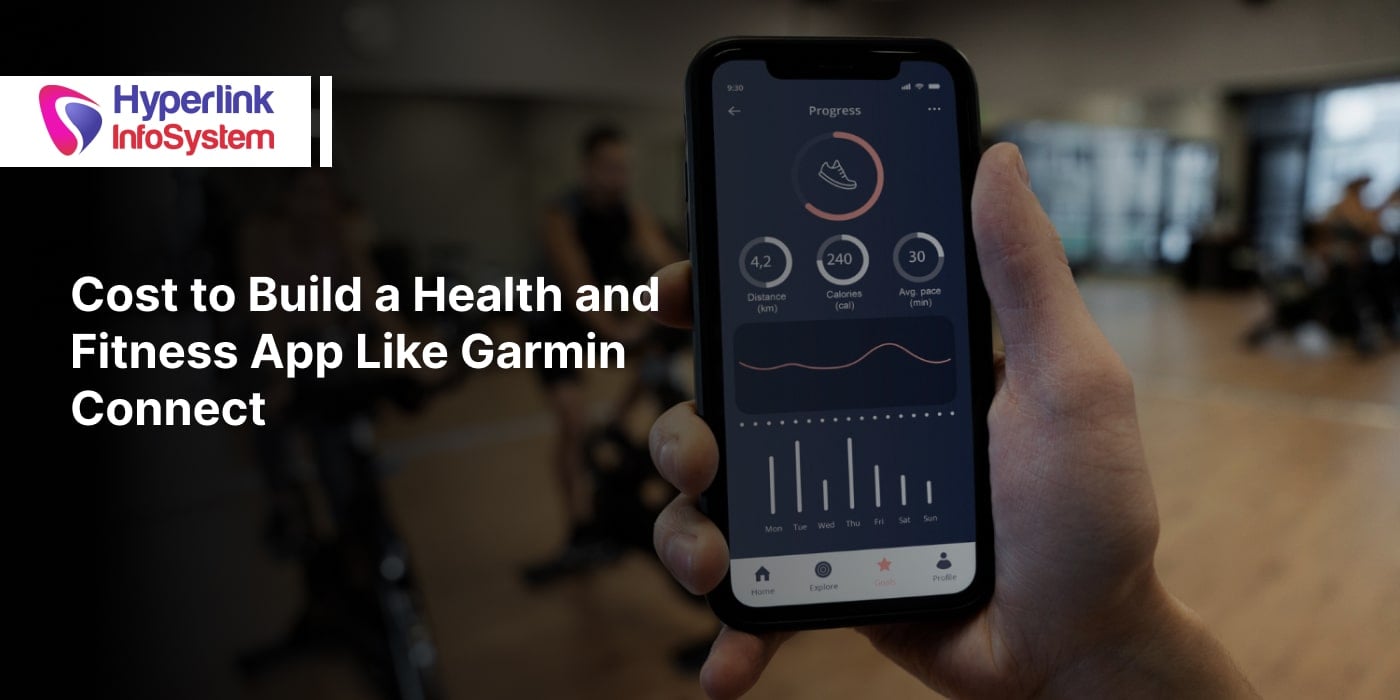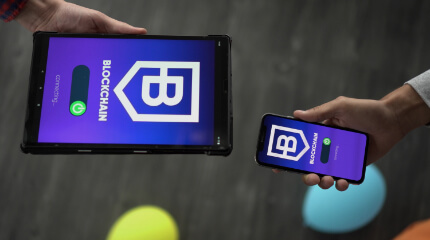Cost to Build a Health and Fitness App Like Garmin Connect: Detailed Guide
Sep 2025

Whether it's developed countries or developing economies, lifestyle diseases like diabetes, hypertension, and obesity are becoming common all over the world. Almost 853 million people will have diabetes by 2050. Similarly, the number of people with hypertension is expected to reach 1.58 billion, while obesity accounts for 1.6 million premature deaths yearly.
Physical activity, such as weight training, is not just for athletes and fitness enthusiasts. It has become a necessity for people leading sedentary lifestyles and individuals seeking to enhance their quality of life. Building a fitness app like Garmin Connect is becoming the rage for companies wanting to cash in on this trend. Nothing wrong with developing fitness apps, but launching them and ensuring long-term profitability is easier said than done.
Whether it's offering personalized workout and diet plans, monitoring vitals, or counting calories, there are many types of fitness apps in the market. On top of that, managing app development costs, building teams, and achieving the best ROI requires a structured and tested approach.
This blog will shed light on the different factors influencing the cost to develop a health and fitness app like Garmin Connect, plus challenges, best practices, monetization strategies, and more. Let’s get started.
Why Build a Fitness App Like Garmin Connect?
The revenue in the health and fitness app market is expected to reach USD 8.30 billion in 2025 and USD 10.30 billion by 2029. These numbers speak for themselves. With so much potential, it is not surprising that companies want to jump on the bandwagon and make some big money. On a more serious note, below are reasons why companies want to build a fitness app like Garmin Connect.
- Booming Market
Fitness and health app downloads grew to $3.6 billion worldwide, and earned over $3.9 billion in revenue. The credit for the popularity of health and fitness apps goes to growing public awareness, increased use of wearables, and remote fitness coaching.
- Popularity of Wearables
Apps like Garmin Connect have gained popularity for their smooth integration with wearables. If you create an app similar to Garmin Connect that works with smartwatches, fitness brands, heart rate monitors, and other IoT devices, you'll see its usage skyrocket in no time.
- Advanced Analytics
People aren’t satisfied with just the basics, like how many calories they’ve burned. They want premium features that include sleep tracking, stress scores, and recovery metrics to enhance their experience.
- Personalization and Coaching
Much like Garmin, the health and fitness app delivers tailored workout suggestions, keeps tabs on your goals, assesses your training status, and features AI-driven coaching to help you along the way.
- Community Features
Features such as leaderboards, challenges, and social sharing encourage healthy competition among users and stay motivated.
- Differentiation Possibilities
Simply mimicking Garmin or another fitness app won’t guarantee your success. Instead, consider other strategies to make your offerings stand out. You could focus on niche audience targeting, incorporate mental wellness aspects, support cross-platform syncing, and add distinctive features like AI-based injury prevention.
Building a fitness app like Garmin Connect is tricky, but it doesn’t mean you should drop your plan. With a reputed mobile application development company by your side, you can create a unique app that delivers value while competing with industry bigshots.
10 Types of Fitness Health Apps
There are many types of health and fitness apps on the market. We will list out some of the most popular types of health and fitness apps.
1) Workout & Exercise Apps
Workout and exercise apps focus on physical training and guided workouts. Examples include Nike Training Club, FItOn, and JEFIT.
2) Nutrition & Diet Apps
This app tracks food consumption, calories, and provides tailored diet plans. Examples of such apps include MyFitnessPal and Yazio.
3) Mental Health and Meditation Apps
The focus of such apps is on mental wellness, mindfulness, and stress relief. Examples of mental health apps include Headspace, Calm, and Insight Timer.
4) Sleep Tracking Apps
Focuses on tracking sleep quality, patterns, and optimization. Examples of sleep tracking apps include Sleep Cycle, Pillow, and ShutEye.
5) Health Monitoring Apps
Health monitoring apps track vitals and health metrics. Examples of such apps include Apple Health, Google Fit, and Samsung Health.
6) Activity Tracker Apps
Tracks daily movements, step counts, distance converted, calories expended, and more. Examples of activity tracker apps include Pacer, Step Tracker, and the Fitbit App.
7) Running & Outdoor Activity Tracker
These applications are great for tracking your physical activities, including the distance you've covered, your pace, the routes you've taken, and even the elevation and terrain. They use GPS to follow your movements. Strava and MapMyRun are a couple of popular options you might want to check out.
8) Habit & Goal Tracker Apps
These apps are all about helping users create and stick to healthy habits. They keep track of things like how much water you drink, how consistently you sleep, your workout routines, and more. Some popular examples of these apps are Habitica, Fabulous, and Streaks.
9) Women’s Health & Period Tracker Apps
The main focus of such apps is on menstrual cycles, fertility, and pregnancy. It tracks menstrual and ovulation cycles, PMS symptoms, fertility windows, and pregnancy milestones.
10) Telemedicine Apps
Telemedicine and health consultation apps make it super easy for users to connect with doctors, therapists, and specialists. With platforms like Teladoc and Zocdoc, you can have online consultations, manage prescriptions, and even get timely reminders to keep you on track.
These are some of the most popular health apps on the market. Do you want to develop a unique health/fitness app for your target audience without blowing your budget? Consult one of the top mobile app development companies for guidance.
9 Factors affecting the costs to develop an app like Garmin Connect
The price tag for creating a fitness app similar to Garmin Connect can vary quite a bit based on a few key factors. These include where you're located, the type and complexity of the app, any hidden costs, the platform you choose, the technology stack, and more. Here’s a rundown of the most important elements that can affect the overall cost of developing an app like Garmin Connect.
1) Type of Health App
The kind of health app you choose to develop can significantly influence the overall costs, especially when it comes to creating something like Garmin Connect. There are a lot of factors to consider, including how complex the features are, the technologies you'll need, the type of content required, and any regulatory requirements. For instance, a straightforward calorie-counting app is relatively easy to put together, especially if it has basic sensor tracking and a user-friendly interface.
In contrast, apps that need real-time data tracking, sleep monitoring, or integration with wearables are much more intricate. They demand more time and effort to develop, not to mention the added challenge of compliance. Even apps that offer personalized workout plans and diet charts can rack up costs if they include advanced features like AI coaching.
When it comes to mental health and meditation apps, they tend to be more budget-friendly to develop. However, the need for top-notch design and quality content can drive up expenses. Telemedicine apps, on the other hand, are often the most time-consuming and costly to create. They have to meet strict privacy regulations while incorporating features like live video streaming, secure messaging, and data storage. Below, you'll find some estimated costs for different types of health apps.
|
App Type |
Basic Version |
Advanced Version |
|
Workout & Exercise |
$20,000 - $40,000 |
$80,000 - $150,000+ |
|
Nutrition and Diet |
$30,000 - $60,000 |
$100,000 - $200,000+ |
|
Meditation/Mental Health |
$15,000 - $30,000 |
$50,000 - $100,000+ |
|
Sleep Tracker |
$40,000 - $80,000 |
$120,000 - $250,000+ |
|
Health Monitoring (Vitals) |
$50,000 - $100,000+ |
$200,000+ (with device support) |
|
Activity/Step Tracker |
$15,000 - $35,000 |
$60,000 - $100,000 |
|
Running/Cycling (GPS-based) |
$25,000 - $50,000 |
$80,000 - $150,000 |
|
Habit/Goal Tracker |
$10,000 - $25,000 |
$40,000 - $70,000 |
|
Period/Fertility Tracker |
$20,000 - $40,000 |
$60,000 - $120,000 |
|
Telemedicine Platform |
$70,000 - $150,000 |
$250,000+ |
The above figures are just to give you a brief idea of the costs to develop different types of health and fitness apps. If you are interested in developing similar apps for your business, consult a mobile app development service provider.
2) App Complexity
The complexity of a health or fitness app plays a big role in determining its development costs. So, what does that mean? Simply put, the more intricate the app, the more resources, time, developers, designers, and testers you'll need to bring it to life. For instance, a basic app like a step counter is relatively easy to create and doesn’t require much in terms of time or resources. It just needs a straightforward design without any backend work or integrations.
On the flip side, building something like Garmin Connect can get pricey due to its advanced features. Incorporating elements like custom workout plans, real-time syncing with wearables, and third-party API integrations can drive up development costs by thousands. Apps that include complex functionalities, such as live video streaming and adherence to data privacy regulations, tend to be the most expensive. A prime example of this is a telemedicine app.
Below is a table-wise cost breakup of health apps by complexity.
Basic App
Features - Simple UI, basic tracking, requires no login or third-party integration.
Estimated Cost - $5,000 - $15,000.
Moderate Complexity Apps
Features - Features include user registration/login, progress charts, API integrations, basic notifications/reminders, and custom workouts or diet plans.
Estimated Cost - $20,000 - $50,000
Highly Complex Apps
Real-time data syncing with wearables, AI/ML for personalized recommendations, Video streaming, In-app purchases/subscriptions, Telemedicine, or chat support, and Social/community features.
Estimated Cost - $60,000 - $300,000+
The above cost table is just to give you a brief idea about health app development costs. If you want to know the exact amount you would have to invest to build an app like Garmin Connect, consult a mobile app development company.
3) App Design Complexity
The intricacy of a health app's design significantly impacts its overall development costs. When the user interface and experience are more advanced, it leads to longer development cycles and increased expenses. For instance, if a company aims to create a basic calorie tracker, it would only need a handful of screens and some static content.
Now, think about apps that feature interactive dashboards, dynamic workout visualizations, and meditation experiences that adapt to the user's mood in real-time. These require a lot more development effort and specialized skills. Plus, complex app designs demand a greater level of innovation and planning, which involves creating wireframes, user flows, and custom graphics. This means designers and developers often have to put in extra hours, working together to achieve a perfect balance between aesthetics and functionality.
Most importantly, the app layouts need to function smoothly across various devices. Delivering such a premium experience takes additional time, talent, and technology, making the design aspect a key factor in determining the costs of developing health apps. Below, you'll find the estimated design-specific costs to build a health and fitness app like Garmin Connect.
UI/UX Research & Wireframing
Estimated Costs - $10,000 - $25,000.
Visual UI Design (50+ screens)
Estimated Costs - $20,000 - $40,000
Interactive Prototyping
$8,000 - $15,000
User Testing & Feedback Iteration
Estimated Costs - $7,000 - $12,000
Custom Animations/Microinteractions
Estimated Costs - $5,000 - $10,000
Dark/Light Mode Support
Estimated Costs - $3,000 - $6,000
The above figures are just to give you a brief idea. Find designers and dedicated developers for hire who can work as per your business needs and create the perfect health app.
4) Backend Complexity
The backend complexity of a health and fitness app impacts the overall development costs. So, what’s behind this? As the term implies, backend development is where all the behind-the-scenes action takes place. It involves tasks like data storage and processing, ensuring everything syncs smoothly across multiple devices, all while keeping it safe from unauthorized access or breaches.
Creating intricate health and fitness apps that monitor various user metrics puts a lot of pressure on the backend infrastructure. When an app goes beyond simple APIs for user logins, local storage, and minimal cloud interaction to include real-time data syncing from wearables, dynamic goal tracking, and machine learning-based recommendations, the backend needs to scale up to manage large volumes and diverse data types. Plus, since these apps deal with sensitive customer information, adhering to regulatory standards is absolutely essential.
Other elements that contribute to rising backend costs include integration with third-party platforms and IoT devices, scaling cloud environments, and providing personalized user experiences. In short, the more complex the app, the more crucial it is for the backend to deliver top-notch performance, along with enhanced security and compliance. Below, you’ll find the estimated backend costs of developing a health and fitness app like Garmin Connect.
API & Microservices Architecture
Estimated One-Time Cost - $40,000 - $70,000
Monthly Operational Costs - Nil
Cloud Infrastructure Setup (AWS/GCP/Azure)
Estimated One-Time Cost - $30,000 - $60,000
Monthly Operational Costs - $5,000 - $20,000
Real-Time Sync & Device Integration
Estimated One-Time Cost - $60,000 - $120,000
Monthly Operational Costs - $3,000 - $8,000
User Auth, Privacy & Security
Estimated One-Time Cost - $25,000 - $50,000
Monthly Operational Costs - $1,000 - $4,000
AI/ML Health-Insights Engine
Estimated One-Time Cost - $50,000 - $100,000
Monthly Operational Costs - $2,000 - $10,000
Analytics Dashboard Backend
Estimated One-Time Cost - $50,000 - $100,000
Monthly Operational Costs - $2,000 - $10,000
DevOps, CI/CD, Monitoring, and Maintenance
Estimated One-Time Cost - $30,000 - $50,000
Monthly Operational Costs - $3,000 - $10,000
The total one-time backend costs can range from $250,000 to $490,000, while the monthly operational backend costs can hover around $14,000 to $54,000. Note that these figures are just to give you a brief idea about backend development costs. Consult a professional mobile app development services company for more information.
5) Third-Party Integrations
When you're creating an app like Garmin Connect, bringing in third-party integrations can really take a toll on your budget. Sure, these integrations are essential, but companies need to carefully choose which ones truly add value for users. For instance, if you're aiming to build a top-notch health and fitness app like Garmin Connect, you'll want to integrate with wearable device APIs, payment gateways, and real-time analytics.
These integrations bring a lot to the table, like syncing fitness data, ensuring secure payment processing, and offering personalized insights for users. While the benefits of these third-party integrations are clear, they also come with a price tag. This includes the need for extra backend infrastructure, specialized developer expertise, and thorough testing to guarantee security, scalability, and compatibility.
For sophisticated apps like Garmin Connect, there are even more expenses to consider, such as licensing fees, usage costs, and contractual commitments. Keeping these complex integrations running smoothly can lead to long-term costs too, like API updates, version changes, or adjusting to new terms from third parties. Below are some of the estimated third-party integration costs for health and fitness apps like Garmin Connect.
Garmin Connect Health API (Rest API)
Estimated Costs - Commercial use requires a license fee or device‑MOQ (financed case-by-case).
Garmin Health SDK
Estimated Costs - Enterprise license or device‑MOQ equivalent; typical one-off fee often $5,000+ depending on scale.
Garmin Integration Total (API+SDK)
Estimated Costs - $10,000–25,000, including license and development work
Wearable Device Integration (With Other Brands)
Estimated Costs - $5,000–25,000+ per platform
Payment Gateway Integration
Estimated Costs - $2,000 - $8,000
GPS/Geolocation
Estimated Costs - $300 - $600
Social Media Login/API Sharing
Estimated Costs - $500 - $6,000
AI/ML Analytics APIs
Estimated Costs - $15,000 - $50,000
Live Streaming/Content Delivery APIs
Estimated Costs - $10,000 - $30,000
Combined Third-Party Integration Cost
Estimated Costs - $20,000 - $70,000, depending on the depth.
The above-mentioned costs are just to give you a brief idea about third-party integration costs. For more information about these costs, consult a professional mobile app development company.
6) Security Considerations
An advanced health and fitness app like Garmin Connect deals with sensitive user information, including biometric and activity data. This data comes from users all over the globe, which means a strong infrastructure is essential, and it also has to meet regulatory standards, driving up development costs. Healthcare providers must adhere to HIPAA because they manage sensitive, protected health information.
Garmin Connect, being a health and fitness app, doesn’t need to ensure HIPAA compliance unless it partners with covered entities like doctors, hospitals, clinics, or health insurance companies.
That said, apps like Garmin Connect can opt to follow HIPAA standards to foster user trust and ensure smooth integrations related to health data. These integrations can significantly raise development costs, typically by about 15 to 20 percent. The actual costs can vary based on the specific regulations, the app itself, and the complexity of the integrations. Below is a rough estimate of security-related costs for a health and fitness app like Garmin Connect.
|
Security Component |
Initial Costs |
Ongoing Monthly Costs |
|
Compliance Planning/Audit |
$10,000 - $30,000 |
Plus Audit Renewals |
|
Encryption Setup |
$3,000 - $12,000 |
Minimal |
|
Access Control & MFA |
$6,000 - $12,000 |
$300 - $1,000/month |
|
Logging and Monitoring |
$5,000 - $10,000 |
$100 - $1,000/month |
|
Threat Detection/SIEM |
$6,000 - $12,000 |
$500 - $3,000/month |
|
Secure Hosting & BAA |
$6,000 - $15,000/year |
$500 - $2,500/month |
|
Incident Response & DRP |
$5,000 - $15,000/year |
$300 - $2,000/month |
|
Security QA/Testing |
$20,000 - $50,000 |
$5,000 - $20,000/year |
|
Total |
$60k - $150k Inital |
$1K - $7K/Month |
7) Compliance Measures
Compliance measures make health and fitness app development complex, thereby increasing development costs. Countries in Europe have data protection laws, such as GDPR, while America has HIPAA. Health and fitness companies’ apps must comply with these regulations because they handle sensitive health and fitness-related data. Ensuring compliance is challenging because companies must build secure systems to store, process, and share personal data.
Advanced Features for Compliance
When it comes to advanced features like managing user consent, encrypting data, setting up secure login systems, and keeping audit logs to monitor data access, there's quite a bit of extra work involved. Beyond the technical side, companies also need to team up with legal experts to create privacy policies, terms of service, and all the necessary regulatory documents.
And let's be honest, legal fees can add up. On top of that, going through official checks or audits, integrating third-party tools for secure monitoring, and getting certified all contribute to the overall costs.
All in all, making sure everything is compliant takes specialized skills, ongoing maintenance, and, of course, legal expenses. Below, you'll find a rough estimate of what compliance-related costs might look like for an app like Garmin Connect. Just keep in mind that these figures are meant to give you a general idea. Consult one of the top fitness app development companies that understands your needs and can deliver accordingly.
GDPR (EU/UK users)
Approximate Costs - $5,000 - $20,000
Estimated Annual Ongoing Costs - $2,000 - $8,000 for policy updates and audits.
HIPAA (U.S. PHI)
Approximate Costs - $10,000 - $50,000
Estimated Annual Ongoing Costs - $5,000 - $20,000 annually.
Data Encryption & MFA
Approximate Costs - $15,000 - $100,000+
Estimated Annual Ongoing Costs - Included in audits and updates.
Third-party integrations
Approximate Costs - $30,000 - $60,000+ (multiple APIs).
Estimated Annual Ongoing Costs - $10,000 - $30,000 annually for API compliance and renewals.
Legal Counsel & Policy Development
Approximate Costs - $15,000 - $60,000 retainer.
Estimated Annual Ongoing Costs - $18,000 - $60,000 legal retainer annually.
Certifications such as ISO
Approximate Costs - $10,000 - $50,000.
Estimated Annual Ongoing Costs - Yearly Renewal fees ranging from $10,000 to $30,000.
8) Platform Selection
Choosing the right platform is crucial when it comes to determining the overall costs of app development, especially for applications like Garmin Connect. Whether you go with iOS, Android, or a cross-platform solution, each option brings its own set of cost implications. The development time, testing requirements, device compatibility, and ongoing maintenance can vary significantly from one platform to another, all of which play a big role in shaping the final development costs.
- IoS Fitness & Health App Development
Native iOS development tends to involve less testing and quality assurance, largely because of Apple’s uniform devices and standardized environment. The Swift language and the Apple ecosystem help to speed up the development process, but be aware that the upfront costs can be quite steep. This is because iOS developers usually expect higher pay, and Apple has more stringent design guidelines to follow.
- Android Fitness & Health App Development
On the other hand, building health and fitness apps for Android can get pretty pricey. This is largely due to the vast array of devices, operating system versions, and screen sizes that you have to consider. To ensure your app runs smoothly on all these different platforms, you'll end up needing to invest more time in testing, debugging, and updates, which can increase costs.
- Cross-Platform Fitness & Health App Development
Cross-platform app development is hands down the most budget-friendly option out there. With tools like Flutter or React Native, developers can create code that runs smoothly on both iOS and Android. While this approach can save companies around 30 to 40 percent in costs, keep in mind that some platform-specific coding is still necessary for features like wearable device integration. The catch? There can be hidden costs and complications that pop up along the way.
Moreover, businesses need to factor in expenses for implementing features such as real-time activity tracking, data visualization, device syncing, and API support, which can quickly become financial sinkholes. Don’t forget about the smaller fees, like the $99 publishing fee for the Android store and $25 for the Play Store.
When choosing a platform, companies should carefully consider their target audience, the features they want, their budget, and performance needs. Below, you’ll find some estimated app development costs that vary based on the platform you choose.
|
Component |
Native iOS |
Android |
Cross-Platform |
|
Development Costs (code and UI/UX) |
$30,000 - $80,000 |
$30,000 - $90,000 |
$40,000 - $120,000 |
|
Testing & QA |
$6,000 - $12,000 |
$10,000 - $20,000 |
$8,000 - $16,000 |
|
Publishing Fee |
$99 per year |
$25 one-time cost |
Same as Native |
|
Maintenance |
$5,000 - $16,000/year |
$6,000 - $18,000/year |
$10,000 - $24,000/year |
|
Backend and Cloud Infra |
$8,000 - $20,000/year |
$8,000 - $20,000/year |
$8,000 - $20,000/year |
|
Wearable Integration |
$8,000 – $15,000 (initial) $2,000 – $4,000/year |
$10,000 – $18,000 (initial) $2,500 – $5,000/year |
$12,000 – $22,000 (initial) $3,000 – $6,000/year |
Note that these platform-specific costs are just to give you a brief idea. Speak to a reputed mobile app development company that can give you an exact estimate.
Technology Stack
The choice of tech stack has a profound impact on the costs to build a health and fitness app like Garmin Connect. Not just the costs, the choice of tech stack also determines how easily and efficiently the app can scale, integrate with other systems, and perform on diverse devices.
- Front-End Frameworks
Typically, developers choose Swift for iOS, Kotlin for Android, and Flutter or React for building apps that work across multiple platforms. Each of these technologies has its unique strengths and weaknesses.
In native app development, developers need to create and manage code for each platform individually. In contrast, cross-platform development allows for a single codebase that operates seamlessly on all platforms, which can significantly reduce both development time and costs. Just keep in mind that this might come with some performance trade-offs.
- Back-End Frameworks
In the world of backend development, the architecture and programming language you select are crucial. Monolithic architecture means everything is integrated into one unit, whereas microservices consist of distinct parts of the application that collaborate. The microservices model is more adaptable and scales better, but it does require additional time for development, testing, and management, which can lead to higher expenses.
Programming languages like Node.js, Python, and Java each come with their advantages and disadvantages, affecting speed and performance in unique ways. For health and fitness apps, it’s essential that data syncing, workout tracking, and health statistics are updated in real-time. Managing a large user base while keeping their data secure necessitates strong backend development. Add in data encryption, real-time analytics, and cloud-based scaling, and you’ll notice the costs can escalate quickly.
- Integrations and Security
The complexity of integrating various wearables can significantly raise development costs, especially for an app like Garmin Connect. This app needs to connect with wearable devices, payment gateways, and health data APIs, which takes considerable time for implementation and testing, causing costs to soar.
Additionally, complying with local data protection regulations, implementing end-to-end encryption, and ensuring secure authentication require specialized expertise and resources, which only adds to the overall expenses.
- AI and ML Capabilities
Apps focused on health and fitness, like Garmin Connect, rely heavily on AI and machine learning to offer customized recommendations, predictive analytics, and motion detection features. For this integration to be effective, the app must gather and sift through massive amounts of user data, which involves a lengthy process of cleaning and organizing before it can be used to train AI models. Many times, companies also have to shell out extra cash for top-notch AI tools from providers like Google or Microsoft. Check out the list below for some of the costs tied to the tech stack.
Front-End
Tech Choices - React Native or Flutter (cross‑platform).
Estimated Costs - $40,000 - $100,000.
Back-End Development and Server APIs
Tech Choices - Node.js (Express/Nest) or Python (Django/Flask)
Estimated Costs - $30,000 - $200,000+.
Database and Storage
Tech Choices - PostgreSQL, MongoDB, cloud storage (AWS/GCP/Azure).
Estimated Costs - $5,000 - $20,000 plus ongoing hosting.
Wearable Device Integration
Tech Choices - Garmin SDK/API, Apple HealthKit, Google Fit, Fitbit.
Estimated Costs - $5,000 - $25,000+ per platform.
Third-Party API Integrations
Tech Choices - GPS/Maps, payments (Stripe/PayPal), analytics, ML/AI.
Estimated Costs - $5,000 - $20,000+ and up $50,000 for machine learning.
AI and Machine Learning Features
Tech Choices - GPS/Maps, payments (Stripe/PayPal), analytics, ML/AI.
Estimated Costs - $5,000 - $20,000+ and up $50,000 for machine learning.
Security and Compliance
Tech Choices - MFA, biometrics, encryption; GDPR/HIPAA compliance.
Estimated Costs - $15,000 - $100,000.
UI/UX Design Complexity
Tech Choices - Custom animations, polished transitions, and responsive UI.
Estimated Costs - $30,000 - $50,000.
Testing and QA
Tech Choices - Manual and automated across devices/platforms.
Estimated Costs - $5,000 - $40,000.
DevOps, CI/CD, Monitoring Tools
Tech Choices - Docker, Kubernetes, Sentry/NewRelic, Jenkins.
Estimated Costs - 1% to 3% of total development costs.
Platform Tools
Tech Choices - Native (iOS + Android) or cross‑platform.
Estimated Costs - Native: $60K–$180K; Cross‑platform: $100K–$300K.
Note that these costs are just to give you a brief idea. Hire app developers with the right skills, experience, and knowledge to develop a custom fitness and health app for your business.
9) Feature Complexity
The more complex the features in a health and fitness app, the more the development efforts and cost. It doesn’t take much to decode this. What are the features that make the costs skyrocket? Below are some of the features found in advanced apps that can hike costs significantly.
- Integration complexity (wearables, GPS, backend sync)
- AI/ML (training datasets, personalization logic)
- Live features (real‑time tracking, video, streaming)
- Data visualization and dashboards (custom UX)
- Gamification & social logic (badges, sharing, community)
- Subscription/payment infrastructures (tiered features)
- Design polish and multi‑platform support (mobile and wearable)
Below are some of the features that affect the costs to build a health and fitness app like Garmin Connect.
Wearable integration (device sync)
Estimated Costs - $25,000 - 55,000.
Live GPS tracking / LiveTrack functionality
Estimated Costs - $12,000 - 25,000.
AI‑driven insights / Active Intelligence
Estimated Costs - $12,000 - 25,000.
Personalized training plans & Coach UI
Estimated Costs - $18,000 - 30,000.
Advanced analytics/dashboard
Estimated Costs - $20,000 - 40,000
Gamification, badges & challenges
Estimated Costs - $20,000 - 40,000
On‑demand video workout library/streaming
Estimated Costs - $20,000 - 60,000.
Subscription payments / Connect and tier setup
Estimated Costs - $8,000 - 20,000 (includes gateway, user tier logic).
Push notifications and reminders
Estimated Costs - $3,000 - 60,000.
Admin dashboard/backend and onboarding
Estimated Costs - $6,000 - 11,000.
Interested in building a unique health and fitness platform like Garmin Connect for your business? Find dedicated developers for hire on professional job portals and platforms online.
10) Development Team
The development team tasked with building a health and fitness app is key in deciding how much the project will cost. Various factors come into play, such as the size of the team, the specific roles required, their geographical location, management overhead, the app's complexity, and more.
For a high-end app like Garmin Connect, you can expect development costs to range from $55,000 to $200,000. Below are some estimated costs related to the development team.
|
Role |
Estimated Hours |
Hourly Rate USD |
Estimated Costs USD |
|
Project Manager / Technical Project Manager |
200 - 400 hours |
$25 - $35/hour |
$5,000 - $14,000 |
|
Solution Architect / Tech Lead |
300 - 500 hours |
$30 - $40/hour |
$9,000 - $20,000 |
|
Senior Mobile Developers |
500 - 800 hours |
$30 - $80/hour |
$15,000 - $64,000 |
|
Backend / Web / DevOps Engineers |
400 - 600 hours |
$30 - $70/hour |
$12,000 - $42,000 |
|
UI/UX Designers |
200 - 300 hours |
$20 - $40/hour |
$4,000 - $12,000 |
|
QA / Test Automation |
200 - 400 hours |
$20 - $40/hour |
$4,000 - $16,000 |
|
Business Analyst / Product Strategist |
150 - 300 hours |
$20 - $30/hour |
$3,000 - $9,000 |
|
Compliance and Security Specialists |
100 - 200 hours |
$30 - $100/hour |
$3,000 - $20,000 |
Geographical Location Matters too. Below are the location-wise development costs.
- India / Southeast Asia - $20 - $50/hr
- Eastern Europe / Latin America - $30 - $80/hr
- North America / Western Europe - Typically $80 - $150+/hr
Whether you want to hire app developers from India, Latin America, or elsewhere is your choice. It is crucial to stay prepared, anticipate challenges, and build a team accordingly.
Top 8 Tips to Limit the Costs When Building an App Like Garmin Connect
When companies embark on the journey of creating a health and fitness app akin to Garmin Connect, they should brace themselves for significant costs. There's no denying that. Fortunately, with the right strategies in place, they can keep those expenses under control. Here are some practical tips to help manage costs while developing an app like Garmin Connect.
- Start with an MVP (Minimum Viable Product). Focus on core features and add advanced features later.
- Use cross-platform frameworks like Flutter or React Native.
- Use existing APIs and SDKs instead of starting from zero.
- Prioritize modular architecture as it allows for future scaling while simplifying updates.
- Outsource to a hybrid team to get high-quality talent while optimizing hourly rates.
- Implement CI/CD and automated testing early to prevent bugs, reduce development time, and avoid expensive fixes.
- Leverage cloud services with scalable pricing, as infrastructure costs can increase significantly as app usage grows.
- Check whether adding/scaling a feature is worth it. Gain real-time user feedback to reduce wasted effort on unpopular features.
Top 9 Challenges Faced by Companies while Developing an App like Garmin Connect
Below are the 9 top challenges that companies face when developing an app like Garmin Connect.
Complex Wearable Integration
Use official SDKs and thoroughly test across device firmware versions.
Real-Time Sync & Data Accuracy
Implement robust background sync with conflict resolution logic.
Backend Infrastructure Scalability
Use cloud-native architecture (e.g., AWS/GCP) with autoscaling support.
Battery & Performance Optimization
Minimize sensor polling and use OS-optimized background services.
Data Privacy and Compliance
Integrate encryption, user consent flows, and regular compliance audits.
Cross-Platform Consistency
Use a shared design system and test early on real devices.
Engagement & User Retention
Gamify progress, use smart notifications, and enable community features.
AI-Driven Personalization
Train models on anonymized data and validate suggestions with users.
Long QA Cycles for Edge Cases
Automate regression testing and simulate real-world scenarios early.
Who Should Consider Building an App Like Garmin Connect?
In the above sections, we discussed the costs to build an app like Garmin Connect. Below are companies and individuals who should consider building an app like Garmin Connect.
- Wearable tech companies such as smartwatch manufacturers, smart ring/health band makers, and IoT health device companies.
- Fitness startups and tech entrepreneurs.
- Healthcare providers and wellness clinics.
- Fitness brands or fitness influencers with a massive social media following.
- Data-driven health and fitness platforms.
- Corporate wellness and solution providers.
Who Should Avoid Creating an App like Garmin Connect?
Below are companies and individuals that should not consider building an app like Garmin Connect.
- Solo founders without technical or hardware expertise.
- Startups that do not offer something unique or cater to a niche audience.
- Businesses with no access to wearable devices or integration partners.
- Health professionals with limited tech or product support.
- Startups on a limited budget. An MVP similar to Garmin Connect requires funding of $100,000 to $250,000 at the very least.
- Individuals/companies with unrealistic expectations, like quick revenue or virality.
Conclusion
Developing a health and fitness app can do wonders for a business, giving it more reach and exposure, brand recognition, and enabling it to compete with industry bigshots. Sure, health and fitness apps have their benefits, but they also come with their share of challenges.
In this blog, we tried to cover multiple aspects related to the costs of building a health and fitness app like Garmin Connect. These insights should help companies build an advanced health and fitness app while navigating challenges and avoiding common mistakes. The trick is to focus on the core features, stick to the plan, and focus on customer needs.
All this sounds easy on paper, but it can be difficult for enterprises that don’t have the time, resources, or technical knowledge to pull it off. That said, giving up is not an option. Hyperlink InfoSystem is here to guide you. With 12+ years of industry experience and 3000+ completed projects under our belt, we are one of the top fitness app development companies with a presence in over 8 countries. Speak to one of our experts to see what we can do for you.
Schedule a Consultation Today!
Latest Blogs

Is BlockChain Technology Worth The H ...
Unfolds The Revolutionary & Versatility Of Blockchain Technology ...


IoT Technology - A Future In Making ...
Everything You Need To Know About IoT Technology ...

Feel Free to Contact Us!
We would be happy to hear from you, please fill in the form below or mail us your requirements on info@hyperlinkinfosystem.com
Hyperlink InfoSystem Bring Transformation For Global Businesses
Starting from listening to your business problems to delivering accurate solutions; we make sure to follow industry-specific standards and combine them with our technical knowledge, development expertise, and extensive research.
4500+
Apps Developed
1200+
Developers
2200+
Websites Designed
140+
Games Developed
120+
AI & IoT Solutions
2700+
Happy Clients
120+
Salesforce Solutions

40+
Data Science

















